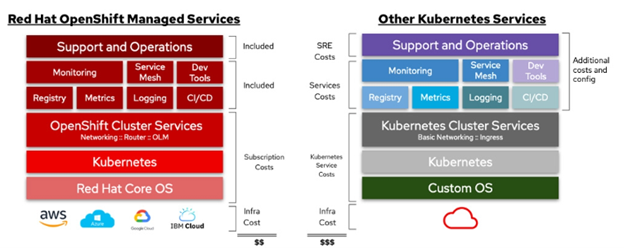
Modernising technology is key to keeping pace with rapid digitalisation. Central to this modernisation is leveraging hybrid cloud environments, which involves the oftentimes complex task of managing multiple clouds, heterogeneous applications and differing sets of tools. Containers are seen as a foundational technology to address app portability and scalability across environments, however, to manage containerised workloads at scale you need a management and orchestration system of which the open-source project Kubernetes (K8s) has become the de facto industry standard.
K8s helps automate the deployment of applications by managing the infrastructure layer across distributed systems providing capabilities such as scaling, resiliency and resource management. However, K8s on its own is not enough. To make it enterprise-ready and more importantly accessible to developers, you need to build components on top of Kubernetes – things like build tools, runtimes, deployment pipelines, monitoring and alerting, security profiles, persistent storage and network routing to name a few. Think of K8s as a platform layer to build your application platform on top of.
Red Hat OpenShift, which is built on top of K8s, adds the critical capabilities to make it more accessible to developers and to simplify operational tasks. In addition to the aforementioned components, OpenShift adds developer-focused services such as service mesh, serverless, GitOps and observability.

To further reduce operational complexity OpenShift is offered as a cloud service across the major cloud providers including AWS and Azure. Red Hat’s Global Site Reliability Engineering team takes care of the Day 1 and Day 2 operations ensuring a 99.95% uptime SLA. This means development teams can focus on delivering business value through building and scaling applications across clouds.
Red Hat OpenShift Is Built Differently
Red Hat has been working on the K8s project since its inception alongside Google. Since then, Red Hat has become the second-leading contributor to the Kubernetes project – with this experience going towards building OpenShift as an enterprise-ready application platform.
Click HERE for a primer on how Red Hat OpenShift is different from others.
As to how Red Hat OpenShift cloud services are different from other hosted K8s services, consider the following:
- OpenShift delivers a consistent experience across the hybrid cloud. Forrester Wave™ assessments rate Red Hat OpenShift as the industry-leading multicloud container development platform. That stamp of approval is in part due to a suite of cloud-agnostic features that enable an organisation’s DevOps team to spread workloads across multiple cloud providers. This ensures consistency for developers and improves their productivity spanning across environments.
- Others are managed but OpenShift is fully managed. In many cases, Kubernetes service providers only manage the actual K8s control plane but other components that need to be put on top require additional costs and configuration (see the figure below). Red Hat OpenShift, in contrast, provides a fully managed service—meaning, it not only manages the entire platform stack, including monitoring, registry and metrics and CI/CD pipelines but also offers said additional components as part of the subscription. Upgrades and patching are automated also, saving you in terms of not only cost but also the major challenge of keeping up with the K8s release cycle.

- OpenShift Cloud Services reduces operational complexity. Red Hat OpenShift’s site reliability engineering team helps reduce security and compliance risks. The platform is covered by 24×7 support. The added deployment flexibility, on the other hand, ensures repeatability and consistency for multi-cloud deployments, thus lessening integration bottlenecks.
Kubernetes Still Needs Help—and Red Hat Can Give it
It is important to keep in mind that K8s is just a means, not the end itself. And for all that it can do for your digital transformation efforts, it still needs to be integrated with a host of other components, including networking, storage, ingress and load balancing, monitoring and logging.
Red Hat OpenShift Cloud Services is a turnkey application platform that not only integrates the components required to build, deploy and run your cloud-native and traditional workloads, it also automates routine operational tasks, accelerating time to value. As a fully managed service, it reduces your risk, enabling teams to focus on delivering innovation.
Put simply, Red Hat OpenShift is not just a product software; it is a key to modernisation. Click here to find out more.





